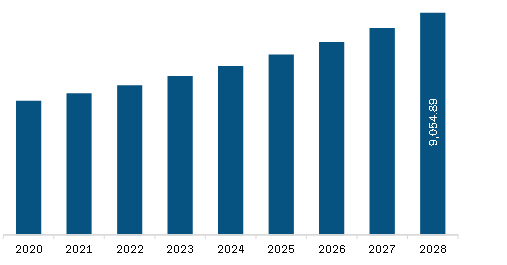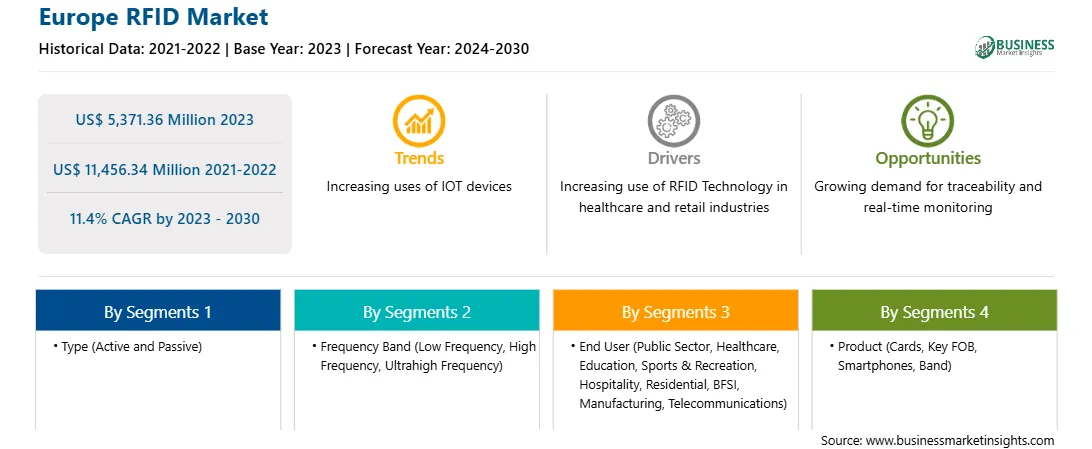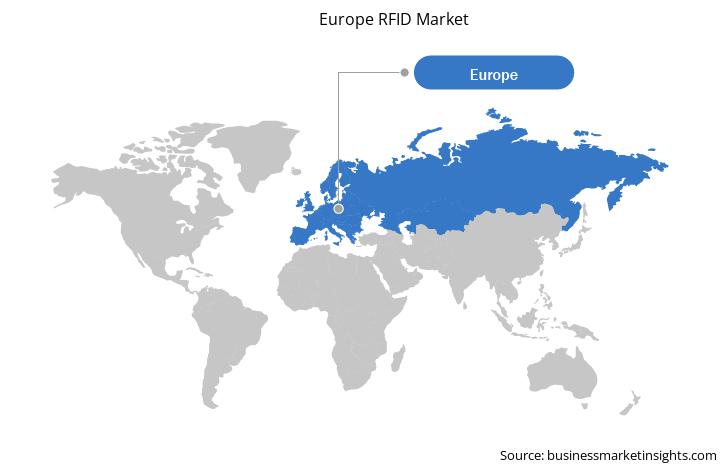RFID technologies are used for various applications in many industries such as food, airline, and blockchain, due to technological advancements and rising awareness regarding their benefits. For instance, RFID tags can be attached to food products to track their movement throughout the supply chain. It helps improve inventory management, prevent food spoilage, and ensure food safety.
Additionally, in April 2021, Stora Enso launched its "world-first" recyclable RFID tag for microwave-safe use. The Eco Meal RFID tag is designed for item-level ready to eat meal tagging and tracking. Such application and product development propel RFID technology adoption in food industries.
In the airline industry, RFID tags can provide accurate information about the location and status of emergency equipment, aircraft systems, and passengers. It can help to improve decision-making during an emergency. Additionally, RFID can help airport authorities improve baggage handling by automating many manual processes, such as checking in bags, loading bags onto airplanes, and unloading bags from airplanes. It can help reduce the wait times for passengers in baggage handling. Such benefits of the technology propel the adoption of RFID technologies in airline industries.
The Europe RFID market in Europe is sub segmented into France, Germany, Italy, Sweden, Belgium, Russia, the UK, and the Rest of Europe. RFID solutions have wide applications in diversified industrial verticals, such as manufacturing, logistics, waste management, and automotive. The retail industry is well established in Europe, with the presence of the world's major retail brands, especially in the clothing sector. RFID technology finds a huge demand in the European retail market. Shoppers are open to scanning Universal Product Codes in self-checkout systems, with RFID tags making self-checkout faster and more precise. Decathlon, a French sports-equipment company with over 1,600 outlets in over 50 countries, tags more than 85% of its merchandise, doubling labor productivity and reducing stockouts to increase revenue by 2.5%. European businesses are also testing several RFID-based checkout technologies. For example, in Europe, the scan-and-go technology allows customers to scan and pay for items using their smartphones, instantly silencing RFID tags and skipping checkout lines. In the age of physical distances, helping customers avoid close contact with checkout personnel provides a competitive advantage.
Further, Europe is known for its high living standards and higher per capita income levels, which has led to the development of smart cities, smart homes, and various other advanced infrastructure projects. RFID products, such as smart locks, sensor locks, and RFID face readers are becoming increasingly popular due to such developments. Such growing smart infrastructural projects drive the RFID technology demand in the region.
Strategic insights for the Europe RFID provides data-driven analysis of the industry landscape, including current trends, key players, and regional nuances. These insights offer actionable recommendations, enabling readers to differentiate themselves from competitors by identifying untapped segments or developing unique value propositions. Leveraging data analytics, these insights help industry players anticipate the market shifts, whether investors, manufacturers, or other stakeholders. A future-oriented perspective is essential, helping stakeholders anticipate market shifts and position themselves for long-term success in this dynamic region. Ultimately, effective strategic insights empower readers to make informed decisions that drive profitability and achieve their business objectives within the market. The geographic scope of the Europe RFID refers to the specific areas in which a business operates and competes. Understanding local distinctions, such as diverse consumer preferences (e.g., demand for specific plug types or battery backup durations), varying economic conditions, and regulatory environments, is crucial for tailoring strategies to specific markets. Businesses can expand their reach by identifying underserved areas or adapting their offerings to meet local demands. A clear market focus allows for more effective resource allocation, targeted marketing campaigns, and better positioning against local competitors, ultimately driving growth in those targeted areas.
Europe RFID Strategic Insights

Europe RFID Report Scope
Report Attribute
Details
Market size in 2023
US$ 5,371.36 Million
Market Size by 2030
US$ 11,456.34 Million
Global CAGR (2023 - 2030)
11.4%
Historical Data
2021-2022
Forecast period
2024-2030
Segments Covered
By Type
By Frequency Band
By End User
By Product
By Offering
Regions and Countries Covered
Europe
Market leaders and key company profiles
Europe RFID Regional Insights

The Europe RFID market is segmented into type, frequency band, end user, product, offering, application, and country.
Based on type, the Europe RFID market is segmented into active and passive. The passive segment held the larger share of the Europe RFID market in 2023.
Based on frequency band, the Europe RFID market is segmented into low frequency, high frequency, and ultrahigh frequency. The high frequency segment held the largest share of the Europe RFID market in 2023.
Based on end user, the Europe RFID market is segmented into public sector, healthcare, education, sports & recreation, hospitality, residential, BFSI, manufacturing, telecommunications, and others. The hospitality segment held the largest share of the Europe RFID market in 2023.
Based on product, the Europe RFID market is segmented into cards, key fob, smartphones, band, and others. The cards segment held the largest share of the Europe RFID market in 2023.
Based on offering, the Europe RFID market is segmented into tags, readers, and software & services. The tags segment held the largest share of the Europe RFID market in 2023.
Based on application, the Europe RFID market is segmented into parcel & mailboxes, lockers, ticketing, and others. The others segment held the largest share of the Europe RFID market in 2023.
Based on country, the Europe RFID market is segmented into France, Germany, the UK, Italy, Russia Sweden, Belgium, Netherlands, Switzerland, and the Rest of Europe. Germany dominated the share of the Europe RFID market in 2023.
APK Identification; Assa Abloy AB; dormakaba Holding AG; Honeywell International Inc; Impinj Inc; OMRON Corp; Siemens AG; and Zebra Technologies Corp are some of the leading companies operating in the Europe RFID market.
The Europe RFID Market is valued at US$ 5,371.36 Million in 2023, it is projected to reach US$ 11,456.34 Million by 2030.
As per our report Europe RFID Market, the market size is valued at US$ 5,371.36 Million in 2023, projecting it to reach US$ 11,456.34 Million by 2030. This translates to a CAGR of approximately 11.4% during the forecast period.
The Europe RFID Market report typically cover these key segments-
The historic period, base year, and forecast period can vary slightly depending on the specific market research report. However, for the Europe RFID Market report:
The Europe RFID Market is populated by several key players, each contributing to its growth and innovation. Some of the major players include:
The Europe RFID Market report is valuable for diverse stakeholders, including:
Essentially, anyone involved in or considering involvement in the Europe RFID Market value chain can benefit from the information contained in a comprehensive market report.